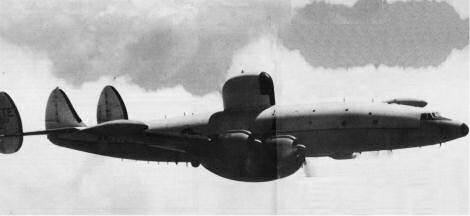 Cruising over cumulus buildups off the coast of Japan TE-11 monitors weather fronts with
its complex array of radar scanners. Flying weatherman sniffed Pacific skies to provide data on possible
typhoon and storm conditions valuable not only to the fleet, but to all civilians residing in the Pacific
Basin.
Cruising over cumulus buildups off the coast of Japan TE-11 monitors weather fronts with
its complex array of radar scanners. Flying weatherman sniffed Pacific skies to provide data on possible
typhoon and storm conditions valuable not only to the fleet, but to all civilians residing in the Pacific
Basin.
On July 1, 1971, the long and colorful career of a most unique Navy squadron came to a final close at the Naval Air Station Agana, Guam. After almost nineteen years of operation during which time they logged over 150,000 hours of the most rugged kinds of flying, the famed Typhoon Trackers of Early Warning Squadron One (VW-1) are no more. Victim of both budgetary cutbacks and new weather reporting technology, the men and planes of VW-1 have been assigned a new, broadened role as part of fleet air reconnaissance. Although their well earned individual identity as the Navy Typhoon Trackers is gone, the exploits and heroism common to this most distinguished squadron of airmen will never be forgotten,
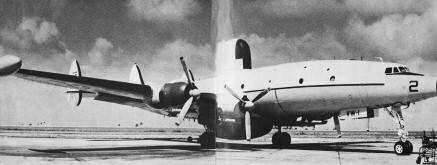 Dubbed Warning Star by the Navy, the WC-121N Super Constellations of Airborne Early
Warning Squadron One logged over 150,000 hours of the most tedious type of flying in their hunt for
Pacific typhoons
Dubbed Warning Star by the Navy, the WC-121N Super Constellations of Airborne Early
Warning Squadron One logged over 150,000 hours of the most tedious type of flying in their hunt for
Pacific typhoons
VW-1 was established 18 June 1952 at Naval Air Station Barber's Point, Hawaii and was given the task of providing long-range radar protection for the fleet. Gradually, that mission came new to include barrier operations and a change of homeport to Naval Air Station Agana, Guam in 1957. In 1961 VW-1's role was modified to the primary mission of weather reconnaissance with airborne early warning remaining as a secondary task. The "Willy Victors," a nickname dating from original WV-2 designation - the WC/EC 121's, Super Constellations served as airborne weather stations on reconnaissance flights that took the aircrat and crews from Midway Island the to U-Tapao, Thailand and from Japan to Kwajalein along with reconnaissance - off the West coast of the United States.
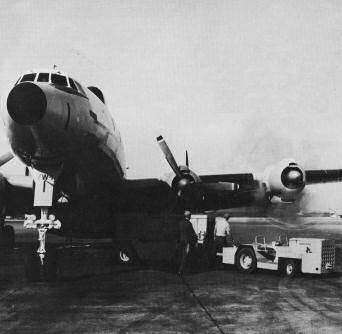 Coming alive with a throaty roar number one Wright Cyclone signals the start of another
reconnaissance flight for the twenty-three man crew of TE-1.
Coming alive with a throaty roar number one Wright Cyclone signals the start of another
reconnaissance flight for the twenty-three man crew of TE-1.
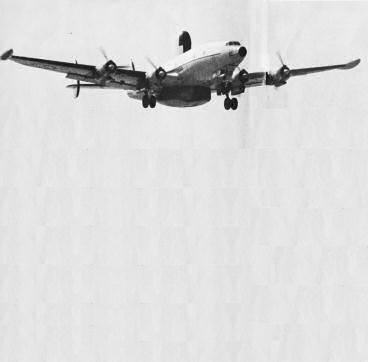 Lifting off the NAS Agana, Guam runway TE-2 begins a westward sweep that will take its
highly trained crew of typhoon hunters on a ten hour mission.
Lifting off the NAS Agana, Guam runway TE-2 begins a westward sweep that will take its
highly trained crew of typhoon hunters on a ten hour mission.
Additional responsibilities came to the squadron in 1964 and 1965. Following the Gulf of Tonkin Incident in 1964, the Commander Seventh Fleet - tasked VW-1 with daily early warning flights in support of fleet units in Southeast Asia. For six and a half years VW-1 flew combat support missions in - the Gulf of Tonkin and has only recently ceased that operation. 1965 found Airborne Early Warning Squadron ONE assuming the added role of training all Navy pilots, aircrewmen, and maintenance personnel for C-121 aircraft in the western Pacific. A reflection of the thoroughness of VW-1 training was the fact that since its establishment in 1952, VW-1 has not had a major aircraft accident and earned the Chief of Naval Operations Aviation Safety Award for the year 1969. Additionally, VW-1 has been twice awarded the Navy Meritorious Unit Commendation while individual aircrewmen have been awarded over - 1200 Air Medals and three Purple Hearts for operations in Southeast Asia.
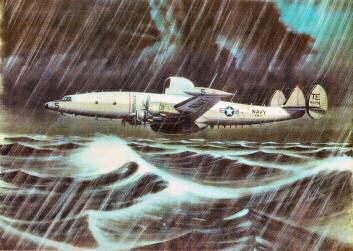 Penetrating the heart of a Typhoon became common duty for the Super-Connie WC-121s as
they flew at wave top level seeking to learn the intensity and path of these Pacific hurricanes.
Penetrating the heart of a Typhoon became common duty for the Super-Connie WC-121s as
they flew at wave top level seeking to learn the intensity and path of these Pacific hurricanes.
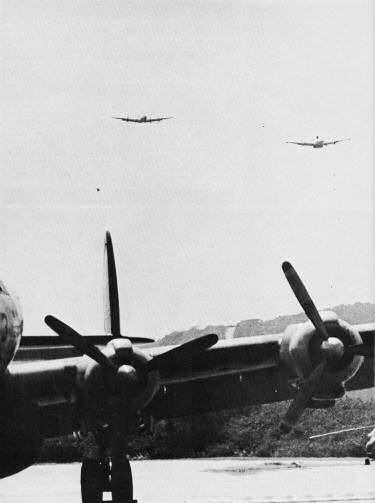 In a last formation fly-by the Typhoon Trackers of VW-1 pass over NAS Agana, their
homeport since 1957. In almost nineteen years of operational flying the squadron maintained a perfect
safety record even though some aircrewmen were wounded during missions in Vietnam.
In a last formation fly-by the Typhoon Trackers of VW-1 pass over NAS Agana, their
homeport since 1957. In almost nineteen years of operational flying the squadron maintained a perfect
safety record even though some aircrewmen were wounded during missions in Vietnam.
Airborne Early Warning Squadron ONE's primary importance lay in its weather mission, and through this task it became one of the few Navy Squadrons to achieve recognition by the general public. This was gained in operations that sent flight crews roaming the entire western Pacific and flying directly into the "eye" of raging typhoons to make a twice-nightly low level position "Fix." Ten years of storm flying earned the men of VW-1 the name "Typhoon Trackers." Penetrating the deadly Pacific equivalents of hurricanes at altitudes of less than a thousand feet in the dark of night placed high demands on the aircraft and the men that fly them. Survival depended on no less than the best of teamwork and timing on the part of all crewmembers when the "Willy Victor" turned to enter a typhoon. The porpoise shaped Super Constellations became familiar and welcome sights at airfields in countries of the Pacific Basin who depend on storm warnings based on data that the "Typhoon Trackers" gain from their flights. Time and again the public turned out in mass to view and applaud road shows and open houses that VW-1 sponsored in WestPac.
Though Navy weather reconnaissance has ended for Airborne Early Warning Squadron ONE, the men and machines of VW-1 that were absorbed into Fleet Air Reconnaissance Squadron ONE (VQ-1), during the ceremonies of July 1, will continue to perform the weather mission. Typhoon reconnaissance remains vital to American Military units in the Pacific as well as to the governments of the Pacific nations, all of who depend on accurate and timely warning to preserve lives and property. Though working under a different name, the former "Typhoon Trackers" will continue to provide their vital service.

